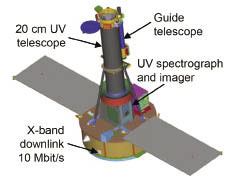Final testing is underway on NASA’s next Small Explorer (SMEX) mission, which will fly into the lower levels of the sun’s atmosphere to use high-resolution images, data collection, and advanced computer models to unravel how matter, light, and energy move from the sun’s 6,000 K (10,240 degree F) surface to its million K (1.8 million degree F) outer atmosphere—the corona. The on-board instrumentation is called the Interface Region Imaging Spectrograph, or IRIS.

The fully integrated spacecraft and instrument for the IRIS mission sits inside a clean room at the Lockheed Martin Space Systems facility in Sunnyvale, CA. The solar arrays are deployed as they will be while in orbit. (Photo: Lockheed Martin)
IRIS will gather information for solar and plasma physics, space weather, and astrophysics, helping researchers understand how internal convective flows power atmospheric activity. It will trace the flow of energy and plasma through the chromosphere and transition region into the corona using spectrometry and imaging technologies. The combination of on-board instruments and 3D modeling, it is hoped, will complete the general knowledge of this dynamic region of the solar atmosphere. New insights are expected to help scientists better understand what drives space weather from the corona to the heliosphere.

The IRIS instrument, as part of NASA’s SMEX mission, is a multi-channel imaging spectrograph with a 20 cm UV telescope.
The ability to complete form and function testing for IRIS was critical in the early stages of design. Engineers needed a physical model to incorporate into the testing process, so they used the latest Direct Digital Manufacturing (DDM) processes, supported by Solid Concepts Inc., Valencia, CA. DDM devices can produce key components in a matter of hours instead of waiting days for a model shop to machine the parts.
The most common DDM process for high accuracy component production is Fused Deposition Modeling (FDM) technology. This technology heats a production-grade thermoplastic material to a semi-liquid state and then extrudes it layer-by-layer in accordance with computer-controlled motion paths until the part is complete. FDM technology incorporates two separate materials into the build, one is the modeling material used for the finished part, the other is a support material used as scaffolding while the part is being grown. Once the build is finished, the scaffolding material easily breaks away or dissolves in a mild detergent and water mixture, leaving an even surface.

Using the latest FDM technology, Solid Concepts was able to build IRIS components that were highly accurate and durable for major testing. The FDM additive manufacturing process delivers highly smooth surfaces.
Thermoplastic parts can endure high heat, chemical exposure, high humidity, as well as extremely dry environments without showing mechanical stress. Materials are available in multiple colors when needed. Plus, complex geometries from this technology can include internal cavities that would be nearly impossible to build using traditional manufacturing methods.
What’s most important for projects like IRIS is the ability to produce highly accurate parts. Solid Concepts produces parts with layer thicknesses as precise as 0.007 in. in most materials, including PC materials known for superior mechanic properties and heat resistance. Tolerances are a function of the machine producing the part and the overall size of the part, and can reach an accuracy of +/-0.0035-in. or +/-0.0015-in./in., whichever is greater.
Solid Concepts
www.solidconcepts.com
Filed Under: Aerospace + defense, Software • 3D CAD, Digital manufacturing, 3D printing • additive • stereolithography, MORE INDUSTRIES





Tell Us What You Think!